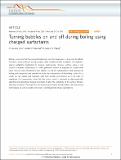| dc.contributor.author | Mizerak, Jordan P. | |
| dc.contributor.author | Wang, Evelyn N. | |
| dc.contributor.author | Cho, Han-Jae Jeremy | |
| dc.date.accessioned | 2015-11-09T12:56:22Z | |
| dc.date.available | 2015-11-09T12:56:22Z | |
| dc.date.issued | 2015-10 | |
| dc.date.submitted | 2015-05 | |
| dc.identifier.issn | 2041-1723 | |
| dc.identifier.uri | http://hdl.handle.net/1721.1/99742 | |
| dc.description.abstract | Boiling—a process that has powered industries since the steam age—is governed by bubble formation. State-of-the-art boiling surfaces often increase bubble nucleation via roughness and/or wettability modification to increase performance. However, without active in situ control of bubbles, temperature or steam generation cannot be adjusted for a given heat input. Here we report the ability to turn bubbles ‘on and off’ independent of heat input during boiling both temporally and spatially via molecular manipulation of the boiling surface. As a result, we can rapidly and reversibly alter heat transfer performance up to an order of magnitude. Our experiments show that this active control is achieved by electrostatically adsorbing and desorbing charged surfactants to alter the wettability of the surface, thereby affecting nucleation. This approach can improve performance and flexibility in existing boiling technologies as well as enable emerging or unprecedented energy applications. | en_US |
| dc.description.sponsorship | Singapore-MIT Alliance for Research and Technology | en_US |
| dc.description.sponsorship | National Science Foundation (U.S.). Materials Research Science and Engineering Centers (Program) (Award DMR-0819762) | en_US |
| dc.language.iso | en_US | |
| dc.publisher | Nature Publishing Group | en_US |
| dc.relation.isversionof | http://dx.doi.org/10.1038/ncomms9599 | en_US |
| dc.rights | Creative Commons Attribution | en_US |
| dc.rights.uri | http://creativecommons.org/licenses/by/4.0/ | en_US |
| dc.source | Nature | en_US |
| dc.title | Turning bubbles on and off during boiling using charged surfactants | en_US |
| dc.type | Article | en_US |
| dc.identifier.citation | Cho, H. Jeremy, Jordan P. Mizerak, and Evelyn N. Wang. “Turning Bubbles on and Off During Boiling Using Charged Surfactants.” Nat Comms 6 (October 21, 2015): 8599. © 2015 Macmillan Publishers Limited | en_US |
| dc.contributor.department | Massachusetts Institute of Technology. Department of Mechanical Engineering | en_US |
| dc.contributor.mitauthor | Cho, Han-Jae Jeremy | en_US |
| dc.contributor.mitauthor | Mizerak, Jordan P. | en_US |
| dc.contributor.mitauthor | Wang, Evelyn N. | en_US |
| dc.relation.journal | Nature Communications | en_US |
| dc.eprint.version | Final published version | en_US |
| dc.type.uri | http://purl.org/eprint/type/JournalArticle | en_US |
| eprint.status | http://purl.org/eprint/status/PeerReviewed | en_US |
| dspace.orderedauthors | Cho, H. Jeremy; Mizerak, Jordan P.; Wang, Evelyn N. | en_US |
| dc.identifier.orcid | https://orcid.org/0000-0002-8272-690X | |
| dc.identifier.orcid | https://orcid.org/0000-0002-8338-4841 | |
| dc.identifier.orcid | https://orcid.org/0000-0001-7045-1200 | |
| mit.license | PUBLISHER_CC | en_US |
| mit.metadata.status | Complete | |
